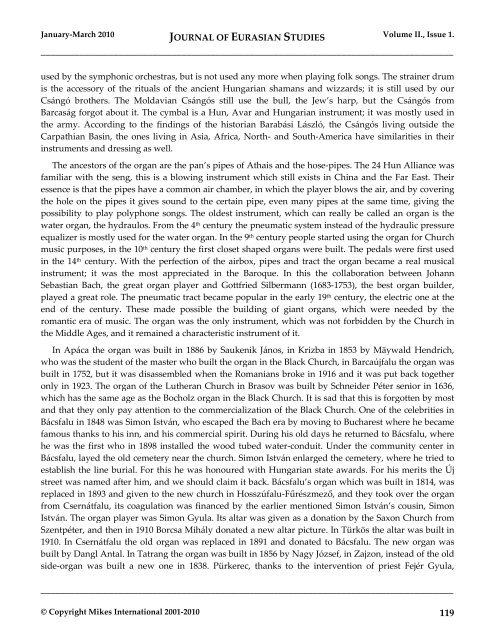EurasianStudies_0110..
EurasianStudies_0110..
EurasianStudies_0110..
You also want an ePaper? Increase the reach of your titles
YUMPU automatically turns print PDFs into web optimized ePapers that Google loves.
January-March 2010 JOURNAL OF EURASIAN STUDIES Volume II., Issue 1.<br />
_____________________________________________________________________________________<br />
used by the symphonic orchestras, but is not used any more when playing folk songs. The strainer drum<br />
is the accessory of the rituals of the ancient Hungarian shamans and wizzards; it is still used by our<br />
Csángó brothers. The Moldavian Csángós still use the bull, the Jew’s harp, but the Csángós from<br />
Barcaság forgot about it. The cymbal is a Hun, Avar and Hungarian instrument; it was mostly used in<br />
the army. According to the findings of the historian Barabási László, the Csángós living outside the<br />
Carpathian Basin, the ones living in Asia, Africa, North- and South-America have similarities in their<br />
instruments and dressing as well.<br />
The ancestors of the organ are the pan’s pipes of Athais and the hose-pipes. The 24 Hun Alliance was<br />
familiar with the seng, this is a blowing instrument which still exists in China and the Far East. Their<br />
essence is that the pipes have a common air chamber, in which the player blows the air, and by covering<br />
the hole on the pipes it gives sound to the certain pipe, even many pipes at the same time, giving the<br />
possibility to play polyphone songs. The oldest instrument, which can really be called an organ is the<br />
water organ, the hydraulos. From the 4 th century the pneumatic system instead of the hydraulic pressure<br />
equalizer is mostly used for the water organ. In the 9 th century people started using the organ for Church<br />
music purposes, in the 10 th century the first closet shaped organs were built. The pedals were first used<br />
in the 14 th century. With the perfection of the airbox, pipes and tract the organ became a real musical<br />
instrument; it was the most appreciated in the Baroque. In this the collaboration between Johann<br />
Sebastian Bach, the great organ player and Gottfried Silbermann (1683-1753), the best organ builder,<br />
played a great role. The pneumatic tract became popular in the early 19 th century, the electric one at the<br />
end of the century. These made possible the building of giant organs, which were needed by the<br />
romantic era of music. The organ was the only instrument, which was not forbidden by the Church in<br />
the Middle Ages, and it remained a characteristic instrument of it.<br />
In Apáca the organ was built in 1886 by Saukenik János, in Krizba in 1853 by Mäywald Hendrich,<br />
who was the student of the master who built the organ in the Black Church, in Barcaújfalu the organ was<br />
built in 1752, but it was disassembled when the Romanians broke in 1916 and it was put back together<br />
only in 1923. The organ of the Lutheran Church in Brasov was built by Schneider Péter senior in 1636,<br />
which has the same age as the Bocholz organ in the Black Church. It is sad that this is forgotten by most<br />
and that they only pay attention to the commercialization of the Black Church. One of the celebrities in<br />
Bácsfalu in 1848 was Simon István, who escaped the Bach era by moving to Bucharest where he became<br />
famous thanks to his inn, and his commercial spirit. During his old days he returned to Bácsfalu, where<br />
he was the first who in 1898 installed the wood tubed water-conduit. Under the community center in<br />
Bácsfalu, layed the old cemetery near the church. Simon István enlarged the cemetery, where he tried to<br />
establish the line burial. For this he was honoured with Hungarian state awards. For his merits the Új<br />
street was named after him, and we should claim it back. Bácsfalu’s organ which was built in 1814, was<br />
replaced in 1893 and given to the new church in Hosszúfalu-Fűrészmező, and they took over the organ<br />
from Csernátfalu, its coagulation was financed by the earlier mentioned Simon István’s cousin, Simon<br />
István. The organ player was Simon Gyula. Its altar was given as a donation by the Saxon Church from<br />
Szentpéter, and then in 1910 Borcsa Mihály donated a new altar picture. In Türkös the altar was built in<br />
1910. In Csernátfalu the old organ was replaced in 1891 and donated to Bácsfalu. The new organ was<br />
built by Dangl Antal. In Tatrang the organ was built in 1856 by Nagy József, in Zajzon, instead of the old<br />
side-organ was built a new one in 1838. Pürkerec, thanks to the intervention of priest Fejér Gyula,<br />
_____________________________________________________________________________________<br />
© Copyright Mikes International 2001-2010 119

















